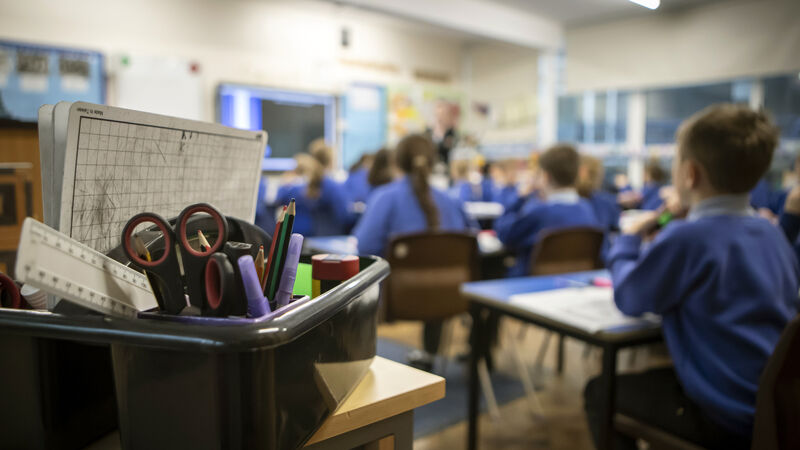Cork teacher: ‘We are propping up broken school system’

What would have happened to those children if they had been lost in a system of 30 plus in a class? So asks one Cork school teacher. Picture: Stock
IN a supposedly modern Ireland, why are teachers supplying pencils, cakes for bake sale, and teaching supersized classes? And why are Special Education Needs (SEN) teachers and pupils with additional needs not being more supported by the state?
Our schools are in crisis. OECD figures show Ireland spends on average 10% less per student at primary level than other developed countries. This lack of funding impacts the principal, school staff and ultimately our children.
Primary capitation for the next school year will be €200 per pupil, the same as it was in 2010, disgracefully, €145 less than post primary. Amid rising fuel and electricity costs, schools are operating with approximately €100 less per pupil this school year that they were last year. This includes the ‘Cost of Living’ grant received this year. Schools simply aren’t being supported enough.
Parents and teachers are asked to pick up the slack, organise bake sales, card drives, sponsored walks and more. This is creating an even greater social divide as DEIS schools, already suffering due to reduced funding, cannot ask parents already living on the bread line to contribute more.
Children are missing out. Some can’t participate in Cumann na mBunscol GAA competitions as the school cannot fund a bus due to an exorbitant electricity bill. Swimming lessons are cancelled as the school oil bill needs to be paid.
Ireland has amazing teachers. A recent PIRLS study ranked Ireland No.2 globally on the Average Reading Achievement and Scale Score. We’ve managed this despite over 60,000 children being in classes of 30 or more.
The average class size in our primary schools remains 23 compared to the EU average of 20 pupils per class. It is a disgrace that Ireland languishes at the bottom of the EU class size table. Imagine how much our children could achieve if the pupil teacher ratio was reduced?
Having been in the unusual situation of having a single stream class of under 20 in recent years, I have seen first-hand the benefits of smaller class sizes. And the most important of these were not academic. The shy, quiet child who rarely offered opinions spoke more freely, gaining in confidence each day. The child with behavioural needs didn’t display challenging behaviour as often, as the teacher had more time to see what prompted the behaviour and pre-empt it. That child had friends for the first time ever, as their peers got to know and understand them.
What would have happened to those children if they had been lost in a system of 30 plus in a class?
Special Education in this country is completely mangled. Over 19,000 teachers are working in the special education setting. Despite the numbers and need, a new allocation model for next year reduced the criteria considered for the allocation of SET hours to schools from five to three. It does not take sufficient account of children whose families are impacted by social deprivation or those who do not speak English as a first language.
While our SEN teachers do an incredible job every day in a variety of settings, there are several barriers to overcome before they can actually do their jobs. Firstly, due to the teacher supply crisis, many schools have not been able to fill the positions of special education teachers (SET). This staffing crisis predominantly, but not exclusively, impacts urban and DEIS schools and special schools.
Secondly, a SET might not get to work with children with most need. If there is a mainstream class teacher absent and no substitute teacher available, the SET is called upon. This is happening every day in schools across the country. This stop gap results in children with the greatest needs not accessing the supports which are supposed to be available to them. They are lost in oversized classes with an overloaded curriculum.
The unavailability of necessary therapeutic, behavioural and psychological supports is a major barrier to the provision of fully inclusive education. SETs are trying to be speech and language therapists, occupational therapists, psychologists and social workers.
Regrettably the length of time the Department has taken to review the model coupled with their problematic approach to SET allocations for the next school year does not inspire much confidence and these wonderful children will stay lost in a supersized classroom.
How to fix this broken system? We need a funding system to fit our schools, not our schools fitting a funding system. We need to reduce our pupil teacher ratio to the EU average at a minimum. We need to address the teacher supply issue and look at the long-term options.
Those who have responsibility for the provision of supports for children with additional needs must recognise and actively listen to the real experts who spend time in classrooms every single day. Until these issues are addressed, children will not be provided with the supports they need to thrive in school.







 App?
App?




